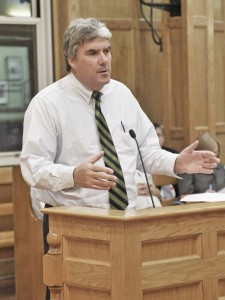WESTFIELD – At the School Committee meeting on Monday, Westfield Public Schools CFO Ronald R. Rix shared the results of the Bach Harrison Survey of Risk and Prevention taken by 951 students in grades 8 through 12 this year,
Rix started with a series of questions for the School Committee members. He asked them not to reveal the questions they were given, but to share their responses. The responses from all were similar, including boredom, depression, family problems, and rebellious behavior. Rix then asked them to share the questions, and they ranged from doing poorly in school, to using tobacco, alcohol and drugs.
Rix said that people tend to focus on the behaviors rather than the root causes, which are similar for most risky behaviors. “Can we do something about the causes? Can we make kids not bored in school?” he asked.
Rix explained that every student in Westfield has both risk and protective factors. He said psycho-social causes for risky behavior include alienation, depression, emotional pain and family problems. He said a high risk student has more risk factors than protective factors, adding “the earlier you intervene, the more success you have.”
Protective factors include a positive youth development model in the family, school, among peers and in the community. Rix said the first connection for kids is with their families, and the next is as they transition to school. At about grades 5-6, they begin to bond with their peers. Rix said as a middle school principal he saw that for years, adding that the bond with a peer group could be positive. The last bond formed is with the community.
Risk factors for Westfield students surveyed that were greater than 5% of the national average included family conflict and attitudes, academic failure, low attachment to school, depression, interaction with anti-social peers, and availability of drugs.
“We can balance the equation in our favor,” Rix said, speaking of risk vs. protective factors. He said in Westfield protective factors greater than 5% of the average included family attachment and opportunities and rewards for pro-social involvement. He said Westfield is strong in students having a belief in a moral order, in social involvement, and in participating in activities that reward involvement.
Rix said the survey showed that 8th graders reported lower use than the national average in all areas. The use of alcohol more than doubles from grade 8 to 10 (10.1% to 46.1%), while the use of marijuana increases almost three fold from grade 8 to 10 (11.3% to 32.7%). Females also reported a higher rate of alcohol use at all three grades, and a slightly higher (2%) rate of marijuana use than males. As for anti-social behaviors, males reported being suspended from school almost three times more than females. He said all reported risky behaviors peak in grade 10,
“There are a lot of things we can do,” Rix said, including delaying the age of alcohol use. He said there is a Rule of 5 factor, which says a kids who starts drinking at age 15 is 5 times more likely to become an alcoholic than those who start at age 20, who are five times more likely than at age 25. He said the most common place kids used alcohol was at home or in someone else’s home with or without parent permission. Other common sources were parties, with someone they know over 21, or having someone they know buy it for them. The location least reported was at school or near school.
He said the new Botvin Life Skills health curriculum which has been introduced in the schools target skills to overcome potentially difficult life situations, asking kids to think about it for two years before doing something risky, and giving them the communication skills to say no.
Rix said other prevention and intervention resources in the schools include positive behavior interventions, before and after school clubs, sports, family involvement, mentors and a wide range of groups to meet identified needs. Community partners that provide resources include the Boys & Girls club, the YMCA, the Athenaeum and Carson Center among other.
Rix said that Westfield students reported higher protective factors than the national average (59.9% to 45.9%). “People can’t believe what we have here,” he said. He also said that kids need trusted adult mentors in all areas of their lives.
Responding to a question from School Committee member Ramon Diaz, Jr. for examples of what the Botvin Life Skills curriculum teaches, WPS Superintendent Stefan Czaporowski said they will be doing a presentation on the curriculum in a couple of months. “There’s more to come,” Czaporowski said.


